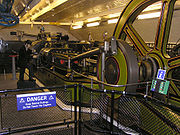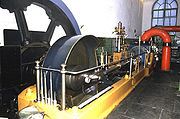
Stationary steam engine
Encyclopedia

Steam engine
A steam engine is a heat engine that performs mechanical work using steam as its working fluid.Steam engines are external combustion engines, where the working fluid is separate from the combustion products. Non-combustion heat sources such as solar power, nuclear power or geothermal energy may be...
s used for pumping or driving mills and factories, and for power generation. They are distinct from locomotive
Locomotive
A locomotive is a railway vehicle that provides the motive power for a train. The word originates from the Latin loco – "from a place", ablative of locus, "place" + Medieval Latin motivus, "causing motion", and is a shortened form of the term locomotive engine, first used in the early 19th...
engines used on railways
Rail transport
Rail transport is a means of conveyance of passengers and goods by way of wheeled vehicles running on rail tracks. In contrast to road transport, where vehicles merely run on a prepared surface, rail vehicles are also directionally guided by the tracks they run on...
, traction engine
Traction engine
A traction engine is a self-propelled steam engine used to move heavy loads on roads, plough ground or to provide power at a chosen location. The name derives from the Latin tractus, meaning 'drawn', since the prime function of any traction engine is to draw a load behind it...
s for heavy steam haulage on roads, steam car
Steam car
A steam car is a light car powered by a steam engine.Steam locomotives, steam engines capable of propelling themselves along either road or rails, developed around one hundred years earlier than internal combustion engine cars although their weight restricted them to agricultural and heavy haulage...
s (and other motor vehicles), agricultural engines used for ploughing or threshing, and marine engine
Marine engine
A marine engine is an engine that propels a ship or boat. Types of marine engine include:*Marine steam engine*Petrol engine or gasoline engine*Diesel engine*Steam turbine*Gas turbine-See also:*Marine propulsion*Engine room*Marine automobile engine...
s.
They were introduced during the 18th century and widely made for the whole of the 19th century and most of the first half of the 20th century, only declining as electricity supply and the internal combustion engine became more widespread.
Types of stationary steam engine

the layout of the cylinders
Cylinder (engine)
A cylinder is the central working part of a reciprocating engine or pump, the space in which a piston travels. Multiple cylinders are commonly arranged side by side in a bank, or engine block, which is typically cast from aluminum or cast iron before receiving precision machine work...
and crankshaft
Crankshaft
The crankshaft, sometimes casually abbreviated to crank, is the part of an engine which translates reciprocating linear piston motion into rotation...
:
- Beam engineBeam engineA beam engine is a type of steam engine where a pivoted overhead beam is used to apply the force from a vertical piston to a vertical connecting rod. This configuration, with the engine directly driving a pump, was first used by Thomas Newcomen around 1705 to remove water from mines in Cornwall...
s have a rocking beamBeam (structure)A beam is a horizontal structural element that is capable of withstanding load primarily by resisting bending. The bending force induced into the material of the beam as a result of the external loads, own weight, span and external reactions to these loads is called a bending moment.- Overview...
providing the connection between the vertical cylinder and crankshaft. - Table engines have the crosshead above the vertical cylinder and the crankshaft below.
- Horizontal engines have a horizontal cylinder.
- Vertical engines have a vertical cylinder.
- Inclined engines have an inclined cylinder.
Stationary engines may be classified by secondary characteristics as well:
- High speed engines are distinguished by fast-acting valves.
- Corliss engineCorliss Steam EngineA Corliss steam engine is a steam engine, fitted with rotary valves and with variable valve timing patented in 1849, invented by and named after the American engineer George Henry Corliss in Providence, Rhode Island....
s are distinguished by special rotary valve gearValve gearThe valve gear of a steam engine is the mechanism that operates the inlet and exhaust valves to admit steam into the cylinder and allow exhaust steam to escape, respectively, at the correct points in the cycle...
. - Uniflow engineUniflow steam engineThe uniflow type of steam engine uses steam that flows in one direction only in each half of the cylinder. Thermal efficiency is increased in the compound and multiple expansion types of steam engine by separating expansion into steps in separate cylinders; in the uniflow design, thermal efficiency...
s have admission valves at the cylinder heads and exhaust ports at the midpoint.
When stationary engines had multiple cylinders, they could be classified as:
- Simple engines, with multiple identical cylinders operating on a common crankshaft.
- Compound engines which use the exhaust from high-pressure cylinders to power low-pressure cylinders.
An engine could be run in simple or condensing mode:
- Simple mode meant the exhaust gas left the cylinder and passed straight into the atmosphere
- In condensing mode, the steam was cooled in a separate cylinder, and changed from vapour to liquid water, creating a vacuum that assisted with the motion. This could be done with a water-cooled plate that acted as a heat sinkHeat sinkA heat sink is a term for a component or assembly that transfers heat generated within a solid material to a fluid medium, such as air or a liquid. Examples of heat sinks are the heat exchangers used in refrigeration and air conditioning systems and the radiator in a car...
, or pumping-in a spray of water.
In order of evolution:
- SaveryThomas SaveryThomas Savery was an English inventor, born at Shilstone, a manor house near Modbury, Devon, England.-Career:Savery became a military engineer, rising to the rank of Captain by 1702, and spent his free time performing experiments in mechanics...
atmospheric engine (1700) - Newcomen engineNewcomen steam engineThe atmospheric engine invented by Thomas Newcomen in 1712, today referred to as a Newcomen steam engine , was the first practical device to harness the power of steam to produce mechanical work. Newcomen engines were used throughout Britain and Europe, principally to pump water out of mines,...
(1712) - Watt engineWatt steam engineThe Watt steam engine was the first type of steam engine to make use of steam at a pressure just above atmospheric to drive the piston helped by a partial vacuum...
(1775) - TrevithickRichard TrevithickRichard Trevithick was a British inventor and mining engineer from Cornwall. His most significant success was the high pressure steam engine and he also built the first full-scale working railway steam locomotive...
(1799) Penydarren Ironworks locomotive, 21 February 1804, - HornblowerJonathan HornblowerJonathan Hornblower was a British pioneer of steam power, the son of Jonathan Hornblower and brother of Jabez Carter Hornblower, two fellow pioneers....
(1781) - WoolfArthur WoolfArthur Woolf was a Cornish engineer, most famous for inventing a high-pressure compound steam engine. As such he made an outstanding contribution to the development and perfection of the Cornish engine.Woolf left Cornwall in 1785 to work for Joseph Bramah's engineering works in London...
(1804) - McNaught'edWilliam McNaught (Glasgow)William McNaught was a Scottish engineer, from Glasgow, who patented a compound steam engine in 1845. This was a technique of improving the efficiency of a standard simple Boulton & Watt beam engine. The engine was compounded by adding a high-pressure cylinder between the support column and the...
compound beam engines (1845) - Cornish engineCornish engineA Cornish engine is a type of steam engine developed in Cornwall, England, mainly for pumping water from a mine. It is a form of beam engine that uses steam at a higher pressure than the earlier engines designed by James Watt...
(1812) - Corliss engineCorliss Steam EngineA Corliss steam engine is a steam engine, fitted with rotary valves and with variable valve timing patented in 1849, invented by and named after the American engineer George Henry Corliss in Providence, Rhode Island....
(1859) - Porter-Allen engine (1862)
- Uniflow engineUniflow steam engineThe uniflow type of steam engine uses steam that flows in one direction only in each half of the cylinder. Thermal efficiency is increased in the compound and multiple expansion types of steam engine by separating expansion into steps in separate cylinders; in the uniflow design, thermal efficiency...
Todd's (1885) - Steam turbineSteam turbineA steam turbine is a mechanical device that extracts thermal energy from pressurized steam, and converts it into rotary motion. Its modern manifestation was invented by Sir Charles Parsons in 1884....
(1889)
Stationary engines may also be classified by their application:
- Pumping engines are found in pumping stationPumping stationPumping stations are facilities including pumps and equipment for pumping fluids from one place to another. They are used for a variety of infrastructure systems, such as the supply of water to canals, the drainage of low-lying land, and the removal of sewage to processing sites.A pumping station...
s. - Mill engines to power textile millCotton millA cotton mill is a factory that houses spinning and weaving machinery. Typically built between 1775 and 1930, mills spun cotton which was an important product during the Industrial Revolution....
s - Winding engineWinding engineA winding engine is a stationary engine used to control a cable, for example to power a mining hoist at a pit head. Electric hoist controllers have replaced proper winding engines in modern mining, but use electric motors that are also traditionally referred to as winding engines.Most proper...
s power various types of hoistHoistHoist may refer to:*Hoist , a machine for lifting loads*hoist controller, a machine for raising and lowering goods or personnel by means of a cable*Hydraulic hooklift hoist, another machine* Hoist , another machine...
s. - RefrigerationRefrigerationRefrigeration is a process in which work is done to move heat from one location to another. This work is traditionally done by mechanical work, but can also be done by magnetism, laser or other means...
engines are typically coupled to ammonia compressors.
Stationary engines could be classified by the manufacturer
- Boulton & Watt
- George Saxon & CoGeorge Saxon & CoGeorge Saxon & Co was a company that manufactured stationary steam engines. It was based in the Openshaw district of Manchester in England. The company produced large steam-driven engines for power stations and later for textile mills in Lancashire and elsewhere.-Biography:George Saxon was born...
See also
- List of steam energy topics
- :Category:Preserved stationary steam engines
- Stationary engineStationary engineA stationary engine is an engine whose framework does not move. It is normally used not to propel a vehicle but to drive a piece of immobile equipment such as a pump or power tool. They may be powered by steam; or oil-burning or internal combustion engines....
- Boilers
- Steam donkeySteam donkeySteam donkey, or donkey engine is the common nickname for a steam-powered winch, or logging engine widely used in past logging operations, though not limited to logging...
External links
- Animated engines - Illustrates a variety of steam engines
- Old Engine House, List of Museums – examples of stationary steam engines preserved in the UK (with pictures and links)
- International Steam.co.uk – comprehensive coverage of stationary steam engines in their original locations, working and non-working, in many countries
- preserved stationary steam engines – includes lesser-known museums containing such engines (UK)
- Steamers steam engine forum – Questions and answers about old steam engines, traction engines
- One Guy from Barlick– Forum discussing Lancashire mill engines

